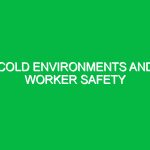In today’s rapidly changing climate, the importance of heat stress prevention has surged, particularly within the Health, Safety, and Environment (HSE) domain. Heat stress occurs when the body becomes unable to regulate its temperature, leading to serious health risks. As temperatures rise globally, understanding how to prevent heat-related illnesses is not just a concern for outdoor workers but for anyone exposed to elevated temperatures. This article delves into the essentials of heat stress prevention, exploring its significance in HSE, the associated hazards, safety precautions, best practices, and relevant regulations.
Understanding Heat Stress and Its Relevance in HSE
Heat stress occurs when the body’s heat gain exceeds its heat loss, resulting in a rise in core body temperature. This condition can manifest in several ways, from heat exhaustion to heat stroke, both of which can be life-threatening. In the HSE context, heat stress is particularly relevant in industries such as construction, agriculture, manufacturing, and emergency services—all fields where employees are often exposed to high temperatures.
According to the Occupational Safety and Health Administration (OSHA), thousands of workers suffer from heat-related illnesses every year, and these numbers are expected to rise as climate change continues to impact weather patterns. The consequences of heat stress extend beyond individual health, affecting productivity, morale, and even workplace safety. Therefore, heat stress prevention is a vital component of any comprehensive HSE strategy.
Identifying Hazards and Risks Associated with Heat Stress
Understanding the various hazards and risks associated with heat stress is crucial for effective prevention. Several factors contribute to heat stress in the workplace, including:
Environmental Factors
Temperature, humidity, and airflow significantly impact a worker’s heat stress level. High humidity impairs the body’s ability to cool itself through sweating, while low airflow can exacerbate heat retention. For example, working in confined spaces without adequate ventilation can dramatically increase the risk of heat stress.
Physical Factors
The intensity of physical activity plays a critical role. Strenuous tasks, especially those involving heavy lifting or high levels of exertion, can elevate body temperature rapidly. For instance, a construction worker lifting heavy materials on a hot day may experience heat stress much sooner than a colleague engaged in less strenuous tasks.
Personal Factors
Individual characteristics, such as age, fitness level, and acclimatization to heat, also affect susceptibility. Older workers and those with underlying health conditions may be at greater risk. Additionally, workers who are not accustomed to high temperatures may experience heat stress more quickly than those who are acclimatized.
Workplace Policies and Training
A lack of adequate training and policies regarding heat stress can exacerbate risks. If workers are unaware of the signs of heat stress or the necessary precautions, they may not take the necessary steps to protect themselves. A personal anecdote comes to mind: A friend working on a roofing project in the summer experienced dizziness and nausea. Despite feeling unwell, he was unaware that these were signs of heat exhaustion, emphasizing the importance of training and awareness.
Safety Precautions and Best Practices for Heat Stress Prevention
To mitigate the risks associated with heat stress, employers and workers must implement specific safety precautions and best practices. Here are several actionable strategies:
1. Hydration
Encouraging workers to drink water regularly is one of the simplest yet most effective ways to prevent heat stress. It is essential to drink fluids before, during, and after work, even if not feeling thirsty. The general recommendation is to drink about 1 cup (8 ounces) of water every 20-30 minutes during exertion in hot conditions.
2. Rest Breaks
Scheduling regular breaks in shaded or air-conditioned areas can help workers cool down. A good rule of thumb is to take breaks every hour, especially during extreme heat. This allows the body to recover and regulate its temperature effectively.
3. Acclimatization
Gradually increasing exposure to hot conditions can help workers acclimatize. New employees or those returning after time away should start with shorter shifts in the heat, progressively increasing their time as their bodies adjust.
4. Appropriate Clothing
Wearing lightweight, loose-fitting, and light-colored clothing can aid in heat stress prevention. Fabrics that wick moisture away from the body can also help keep the skin cool. Employers should consider providing appropriate clothing for outdoor workers.
5. Monitoring and Awareness
Implementing a monitoring system for heat stress can be invaluable. This might include having designated “heat safety monitors” who observe workers for signs of heat stress and ensure that safety protocols are being followed. Training employees to recognize symptoms of heat stress in themselves and their colleagues is equally important.
Specific Regulations and Standards Governing Heat Stress Prevention
Several regulations and standards govern heat stress prevention to ensure worker safety. Notable among these are:
Occupational Safety and Health Administration (OSHA)
OSHA has not yet established a specific regulation for heat stress; however, it enforces general duty clauses requiring employers to provide a safe working environment. Employers are encouraged to implement heat stress prevention programs, including training and monitoring.
American National Standards Institute (ANSI)
ANSI has developed standards related to heat stress that provide guidelines for employers. ANSI/ISEA 105-2016 outlines methods for testing and classifying protective clothing for thermal hazards, ensuring that workers have the necessary gear to combat heat stress.
National Institute for Occupational Safety and Health (NIOSH)
NIOSH provides recommendations for preventing heat stress, including guidelines for water intake, acclimatization, and the importance of education on the risks of heat-related illnesses. Their resources are vital for both employers and employees to create a comprehensive heat stress prevention plan.
Conclusion
Heat stress prevention is a significant aspect of health and safety in various industries, particularly as climate patterns evolve. By understanding the risks associated with heat stress, implementing effective safety precautions, and adhering to relevant regulations, employers can create a safer work environment for their employees. As individuals, recognizing the signs of heat stress and taking proactive measures can protect our health and well-being. In the end, fostering a culture of safety and awareness around heat stress not only enhances productivity but also saves lives.
Incorporating heat stress prevention strategies into the workplace is not merely a regulatory obligation; it is a moral imperative. Let’s continue to prioritize safety in our work environments, ensuring that heat stress becomes a thing of the past.


